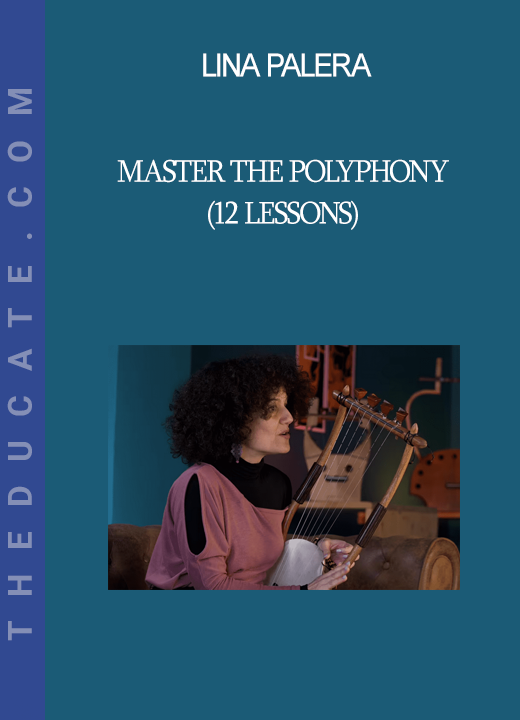Description
Lina Palera – Master The Polyphony (12 Lessons)
Ready to become a master of polyphony and implement it to bring a second or even a third voice into your lyre playing? If yes, then this Lyre Masterclass is for you, specially designed for the advanced players willing to master their lyres.
Everything you need to know, mindfully packed into one course: we will see how to add extra voices to any given melody, what is a fugue, why so many legendary composers used that composition technique (including Mozart, Beethoven, and Shostakovich), what is an exposition, a development, and a final entry? What’s more, we will put everything into practice by learning how to play a Fugue with three voices, specially composed for a 7strings lyre in G major. Last, we are going to see practical tips on how to get the most out of polyphony!
So, are you ready to take the challenge and become one of the very few lyre players out there capable of applying polyphony in their melodies and playing an entire Fugue on just 7 strings?
This course is for competent lyre players who have preferably (but not obligatory) completed the Advanced Semester of the LyreAcademy. What’s more, it is for lyres of any type with at least 7 strings.*
At the end of the course you will know how to…
- Implement to your lyre playing a very advanced technique, the polyphony.
- Add several challenging exercises to your daily practice routine.
- Add a 2nd or even a 3rd voice to your melodies.
- Harmonize any given melody.
- Play seven demanding polyphonic melodies.
- Apply counterpoint music to your lyre playing.
- Approach a Fugue.
- Analyze a Fugue’s morphology.
- Play a complete Fugue on a 7strings lyre.
* Do you own a lyre with more strings?
The course can be done by students with
a lyre or a kithara with 7 or more strings. Simple and step-by-step videos are available to prepare your lyre for the courses (including tuning).
Lesson 1: Warm up with Specialized Lyre Exercises
Ready to take up the challenge and become one of the very few lyre players worldwide able to implement polyphony into their playing? This is a this introductory lesson, we are going to warm up with exercises specially designed for polyphony playing.
Lesson 2: Adding a 2nd Voice to a Melody
It’s time for you to add a second voice to a given melody and understand what is and how to apply two voices polyphony into your playing.
Lesson 3: Learn How to Harmonize a Melody
Did you know that there isn’t “one right way” to harmonize a melody, but many different ones? In this lesson, we are going to explore several of them and understand how our harmonizing approach can affect both the final melody and what our audience perceives by listening to it. And all of the above while learning our first polyphonic melody.
Lesson 4: Learn to Play the “Impulsive” Melody, Polyphony in 7/8 rhythm
Ready to go one step further and explore polyphony using a different and more demanding rhythm –the 7/8 rhythm- while learning how to play another polyphonic melody?
Lesson 5: The Role of Every Voice in a Polyphonic Melody
Ready to learn, step-by-step, your first polyphonic melody, the one titled “Ornament,” while understanding in depth what role each voice can play in a polyphonic piece of music?
Lesson 6: Two Voices, Polyphony, and the ancient Greek Phrygios mode
In this lesson, we are going to put into practice everything we have learned in theory so far! We will learn, step-by-step, a polyphonic melody with two voices, using the ancient Greek Phrygios mode!
Lesson 7: Applying Counterpoint Music to our Lyre Playing
Ready to understand what Counterpoint Music is, and why is it so important when applying polyphony in your lyre playing?
Lesson 8: Learn a Lyre Piece of Music with Two Voices
It’s time to learn, step-by-step, a counterpoint piece of music, written for two voices, in our 7strings lyre.
Plus: Sheet music for a lyre
Lesson 9: Learn a Lyre Piece of Music with Three Voices
Ready to go even deeper by learning step-by-step a counterpoint piece of music, written not in two by in three voices, in your 7strings lyre? Plus: Sheet music for a lyre
Lesson 10: Playing a Fugue on the Lyre, Part 1
In this introductory lesson, we will explore what a fugue is and why it is
crucial to know the theory before heading to practice?
Lesson 11: Playing a Fugue on the Lyre, Part 11
Let’s dive really deep into a three voices fugue in G Major for a 7strings lyre by looking closely at its morphology.
Masterclass Finale: Playing a Fugue on the Lyre, Part III
Time to master your first fugue, a unique piece of music specially written for an ancient lyre with 7strings. In this final lesson, we are going to learn step-by-step a very demanding piece of music, a three-voice fugue in G Major!
Where do I go from here?
So, you have just finished the masterclass M06 and want to further advance your lyre playing? Take a quick look on our lyre tutors semester, focusing on teaching the lyre to beginner, intermediate and advanced lyre players, and eventually becoming a LyreAcademy certified lyre tutor!
Who is your Instructor?
Lina Palera is a world- renowned lyre player and a charismatic teacher with more than a decade of experience in music schools and educational institutions in the United Kingdom, Greece and abroad, working with adults and children too. She travels a lot for live performances at museums, festivals, conferences and other venues.
Proof Content
 Sale page: https://lyreacademy.com/master-the-polyphony-masterclass-m06/
Sale page: https://lyreacademy.com/master-the-polyphony-masterclass-m06/
Archive: https://archive.ph/wip/yykQC







Reviews
There are no reviews yet.